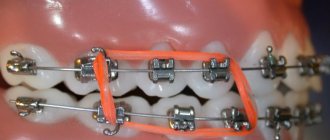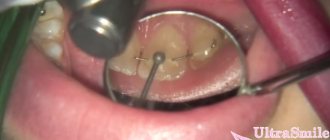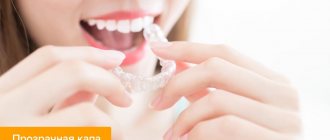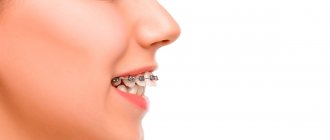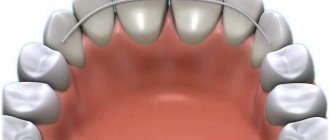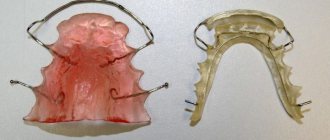Many people believe that braces destroy enamel, promote tooth decay, and cause other dental diseases. Is this really true? Should a person refuse orthodontic treatment if there is a risk of damage to teeth or gums? In this article we will answer these questions.
In this article
- Do braces damage teeth?
- Why do teeth get damaged from braces?
- How to prevent enamel damage when wearing braces
- Hygiene with braces
Braces are complex structures consisting of several parts: screws, locks, arches, etc. As a rule, they are made of metal. If the system is made of another material, such as plastic, ceramic or sapphire, the arc will still be metal. The braces are fixed directly to the tooth enamel using special dental glue and cement. They cannot be removed. A person has to wear the appliance for several months or years, it all depends on the pathology of the bite.
Many patients who have undergone orthodontic treatment report that their teeth deteriorate due to braces. In their opinion, while wearing a dental structure, the enamel becomes thinner, caries often develops, gums become inflamed, etc. According to doctors, such complications occur in medical practice, but braces are not to blame. Let's find out what exactly causes these complications.
Do braces damage teeth?
So, do braces damage enamel? Caries, gum inflammation and remineralization of the tooth surface are quite common complications that are identified during orthodontic treatment or after its completion and removal of braces. Some believe that the orthodontic structures themselves are to blame. Firstly, they scratch the enamel, and secondly, a large number of bacteria accumulate under the locks and arches, which cause demineralization and caries. These are some of the most common myths about braces.
Orthodontic braces fit tightly to the teeth and do not move. Bite correction is carried out due to the pressure that the arch exerts on the jaw. Throughout the entire treatment period, the locks of the structure remain in the same places where they were fixed, so they can scratch the enamel only due to injury or due to improper installation of braces, which is extremely rare.
There is no space left between the brace clasps and the teeth for germs to enter. On the contrary, the lock protects the area of enamel on which it is installed from external factors. Moreover, dental glue contains fluoride and other minerals that help strengthen the tooth surface.
Thus, if braces are installed correctly and the patient follows the rules of wearing them, they cannot harm the teeth and other tissues of the oral cavity. What causes complications in this case?
Myth 2. Age affects the ability to be treated with braces.
Many patients are surprised that they can be treated with braces at 30, 40, 50, 60 and 70 years old! And in general at any age.
There are two categories of orthodontic patients:
- The patient is at the stage of jaw growth, peak growth usually occurs at 11-12 years of age.
- The patient is no longer growing - he has a full set of teeth and jaw growth has stopped, most often he is 15-16 years old and older.
In the first case, the orthodontist works with the teeth and jaw, in the other - only with the teeth. At the stage of stopped growth, jaw correction can only be performed by an orthognathic surgeon. But there are no age restrictions for aligning the dentition and correcting the bite.
Why do teeth get damaged from braces?
Dentists name the following reasons for complications arising from wearing braces:
Incorrect installation of the structure
Before the procedure, the patient undergoes an examination, if necessary, treatment of associated pathologies, elimination of carious cavities and professional teeth cleaning. If at this stage the doctor makes a mistake and installs braces in the presence of one or another pathology of the oral cavity, complications may subsequently arise. There is also a possibility that the doctor will fix the locks poorly and gaps will form between them. Because of this, caries can develop.
Use of low-quality materials
The glue used to attach the structure to the teeth must contain fluoride. If it is absent or is contained in small quantities, the protective properties of the film between the lock and the enamel are significantly weakened. Because of this, the risk of developing a carious process increases.
Poor hygiene
The braces system greatly complicates the procedure of cleaning teeth. To maintain oral hygiene, you need to spend a lot of time and money on it. In addition, it is necessary to use additional devices for cleaning teeth and braces. If a person does not do this and does not follow the orthodontist’s recommendations, he is more likely to suffer from caries and other dental diseases.
Poor nutrition
After installing braces, the patient must adhere to a certain diet. He will have to give up a number of foods, otherwise he risks damaging the braces or causing disease of the teeth and gums. Some believe that braces are the cause. However, the main factor in development is poor nutrition.
Pregnancy
Usually pregnant women do not get braces. But there are cases when a woman becomes pregnant after having braces installed. During gestation, the fetus needs a large amount of microelements. Because of this, a lack of calcium and fluoride may form in the body, which affects the condition of the enamel. Pregnant women are advised to eat right and take special medications with vitamins and minerals.
Myth 3. You need to come to the orthodontist when all your permanent teeth have erupted.
This myth is often spread by dentists. They say that, despite the problems, there is no need to show the child to the orthodontist now, let all the teeth erupt.
This is an outdated approach. Indeed, there are situations in which it is worth waiting for a complete change in the bite. But there are problems that require urgent treatment, sometimes even at 5-6 years old. These are mainly pronounced bite pathologies - an overdeveloped upper or lower jaw, which is caused by bad habits, and if we wait until all the teeth erupt and jaw growth stops, then surgery will be the only option to solve the problem. There is no need to condemn your child to this from the very beginning.
Sometimes, even in early childhood, the doctor and parents notice that the child swallows incorrectly or has a bad habit of sucking his tongue, finger, or some other object. In this case, it is enough to pay attention to this habit and start fighting it early - either on your own or with the help of a speech therapist with special exercises. There are also orthodontic devices for correcting such habits - for example, a plate with a tongue barrier.
While the child is small, has baby teeth and jaws are still growing, it is often enough to remove the cause of the developing bite pathology. If this is not done in time, this can lead to significant deformities that will be very difficult or impossible to treat without surgery.
There are two stages of jaw growth spurts - at 1.5 years and at 6-7 years. This moment can be used to stimulate jaw growth using devices. If the child wears the removable device well, the treatment will work. But parents’ efforts are also needed, because the child’s compliance with the recommendations must be monitored.
Therefore, it is obvious that it makes sense to visit an orthodontist and, if there are problems, start working on them as early as possible, so as not to miss the moment to give your child a beautiful smile and harmonious facial features.
How to prevent enamel damage when wearing braces
To maintain dental health while wearing orthodontic braces, the patient must adhere to a diet and carefully practice good hygiene. First, we’ll tell you how a person with braces should eat.
Immediately after their installation, you can only eat soft or liquid food in order to quickly get used to the design. Subsequently, you should refuse:
- Hard products: nuts, a number of fruits and vegetables, dried fruits, crackers, hard meat, etc. They can damage the arch structure, gums or enamel. Damage to braces will require additional costs. However, this does not mean that you will have to completely exclude carrots, nuts and other foods from your diet - they can be eaten pureed.
- Sticky food: candies and chocolate with nougat, corn flakes, chewing gum, cheeses, etc. The remains of such products stick to the braces and become a source for the spread of bacteria. In addition, most of these foods contain a lot of fast carbohydrates, which feed cariogenic bacteria. Because of this, caries can develop.
- Products with small grains: raspberries, chia, sesame, strawberries, kiwi, etc. The seeds from these products end up in locks, and it is quite difficult to clean them out. The functionality of the braces may be impaired. In addition, microbes will begin to actively multiply in the parts of the staples, which contribute to the occurrence of various diseases.
- Foods and drinks with dyes: coffee, tea, soda, etc. You don’t need to give them up completely, but you will still have to limit their consumption, otherwise the braces will darken first, and then the enamel. In addition, dyes cause plaque and tartar to form faster, which is a favorable environment for the spread of bacteria.
Also, a patient with braces needs to observe the temperature regime while eating. It is not recommended to eat food that is too hot or cold, which can affect the braces and enamel. While wearing braces, it is advisable to eat healthy foods containing vitamins and minerals. They speed up the process of restoring the structure of the tooth surface.
Myth 5. After the plate in childhood, braces are not needed
If a patient had treatment with a plate or partial braces in childhood, this does not always guarantee avoidance of orthodontic treatment in the future. Very often during consultations we hear from parents of teenagers that they previously had treatment with braces, in which case it is quite difficult to explain the need for repeated treatment. You need to understand that orthodontic treatment can be carried out in several stages. The first stage is in childhood with the help of a plate or partial braces, and the second stage is in adolescence, already at the stage of permanent dentition.
Hygiene with braces
A person with braces takes about 10 minutes to brush their teeth in the morning and evening. In addition, you will have to clean and rinse your mouth several times during the day - after each meal. To do this, you need to use special hygiene products. Among them:
- An orthodontic brush with a depression in the center of the bristles (V-shaped), such as CURAPROX Ortho. Thanks to this shape of the bristles, it cleans well not only the teeth, but also the structure itself. You should spend at least 3-4 minutes cleaning with this brush in the morning and evening.
- Mono-beam brush (Curaden International CURAPROX 1006 Single & Sulcular, Cumdente Gmbh CURAPROX 1006 Single & Sulcular). It can be used to clean each tooth individually. This brush is especially convenient for cleaning molars and numbers of eights. It is used after standard cleaning.
- A brush is an orthodontic device made of wire and bristles, the length of which decreases from base to tip (Curaprox CPS 10, Biorepair Scovolini Interdentali Cilindrici). Using a brush, the space between the arch and the teeth is cleaned, as well as around the brace locks. The brush should be used after every meal.
- Dental floss with hard fibers (Mirafloss implant chx). It helps clean the interdental spaces. It should be used at least once a day, especially after eating fibrous foods such as meat.
- Rinse aid (Biorepair Mouthwash). You will need it immediately after eating for cleansing and disinfection. It is advisable to purchase products that contain calcium.
- An irrigator is a device that allows you to efficiently clean the interdental spaces from food debris and germs, as well as remove plaque. It must be used at least 2-3 times a week. For people who often travel, a portable irrigator (Panasonic EW-1411) is suitable, and for home use you can buy a stationary device (Donfeel OR-820D Compact). Choose models with attachments for orthodontic structures.
It is better to buy all these products after consulting a doctor. Do not forget about the preventive examinations that the orthodontist will prescribe. At the first symptoms of caries and other pathologies, consult a doctor without waiting for a routine examination.
Myth No. 1. Correcting an overbite is very painful.
This is greatly exaggerated. Most patients who wear braces note that they felt some discomfort for the first 2-3 days after installation/activation. The level of this discomfort is individual and depends on the person’s pain sensitivity threshold. In the vast majority of patients, the intensity of pain is minimal. Some sensitivity when eating at first is normal, choose something softer to reduce the stress.
In the vast majority of patients, the intensity of pain when wearing braces is minimal.
Types of retainers
Depending on the characteristics of malocclusion and the degree of results achieved, the orthodontist determines the tactics of the retention period regarding the type of structure, the duration of daily exposure to retainers and the timing of their wearing.
There are two main types of retainers.
- Fixed. They are a thin wire that is fixed on the inside of the teeth using special glue or filling material. The retainer is absolutely invisible to prying eyes, does not cause significant discomfort and does not affect diction.
- Removable. Several types of removable retainers are produced, but the main design is presented in the form of a mouthguard, which is made exclusively individually in accordance with the anatomical features of the patient’s teeth and jaw. Removable retainers are worn primarily at night or for several hours a day.
Trainers, plates, mouthguards and aligners are used in the form of removable orthodontic products for the retention period.
A removable design requires longer adaptation and regular wearing of the structure. Orthodontists recommend that parents monitor compliance with the requirements for correction, and if there are indications for wearing a structure, they should always give preference to non-removable retainers.
Causes of caries
Caries, the main disease of teeth, comes down to the destruction of their hard tissues, as a result of which cavities form in them. For a tooth to get sick, just one condition is enough - the formation of plaque on its surface from the remnants of food eaten. Microorganisms living in the plaque layer feed on it and, in the process of vital activity, release aggressive acid that specifically destroys tooth enamel.
To start the destructive carious process, the amount of plaque on the teeth must reach a certain concentration. Remember where cavities most often form? Not at all on the smooth surface of the tooth, where plaque is most easily removed with a toothbrush, but in fissures - depressions on the chewing surface of the teeth, pits and places of particularly crowded teeth, where cleaning is difficult.
Braces themselves cannot destroy teeth. They are glued with a special glue with the addition of a special protector that protects the surface of the tooth under the braces from caries. But along the edges of the bonded bracket, it does create an uneven surface in which plaque can accumulate. Therefore, in patients who pay little attention to dental hygiene, the risk of caries when wearing orthodontic systems increases.

